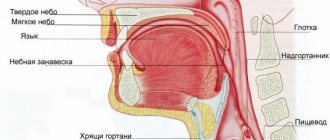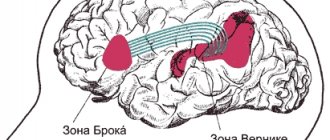The most important feature of a person is his ability to pronounce sounds, which is facilitated by the structure of the speech apparatus. It is necessary so that people can exchange thoughts and communicate with each other. This is a very complex mechanism, the successful functioning of which requires the coordinated work of each component. The structure is represented by two sections: central (the human brain) and peripheral or executive.
Definition and purpose
In science, the speech apparatus is usually understood as a set of human organs intended for the formation of speech. The central section, represented by the brain and individual formations of the central nervous system, performs a regulatory function. Main destination:
- To form oral speech, the frontal gyrus of Broca's area is necessary, which forms the motor area.
- People perceive the speech of their interlocutor thanks to the speech-auditory area, which includes the temporal gyrus of Wernicke's center.
- The parietal lobe is responsible for understanding.
- The assimilation of words during the perception of written speech (when reading or writing) occurs thanks to the visual zone located in the occipital lobe.
In addition, the diagram of the human speech apparatus includes the peripheral or executive department, which consists of nerves, bones and muscles.
Features of the executive department
It includes three major structural divisions. The first is the respiratory section. Its activity, which is a sequence of inputs, exhalations and pauses between them, is regulated by the central nervous system. The main working “tool” is the diaphragm, which expands and contracts, due to which the lungs change volume and produce inhalations and exhalations. In this case, an air stream is formed, which is important for the formation of the voice; the clarity of the pronunciation of speech sounds depends on its intensity. In addition, the respiratory department includes:
The functions of the air stream are voice-forming and articulatory. The sound is formed when you exhale, and the inhalation when speaking becomes deeper and shorter. The number of respiratory movements performed during speech is much greater than directly during physiological breathing. The volume of air inhaled and exhaled during conversations is three times greater than during normal inhalations and exhalations.
Voice education
In the structure and functioning of the speech apparatus, the vocal section plays the most important role; it is responsible for the formation of the voice and its characteristics - timbre, strength, pitch. It includes the larynx and vocal cords, which, vibrating under the influence of an air stream, produce sounds.
The larynx is a tube consisting of soft tissues and cartilage; in its upper part it passes into the pharynx, in the lower part into the trachea. In the place where the larynx connects to the pharynx, the epiglottis is located, which serves as a kind of valve when swallowing: by descending, it prevents pieces of food and saliva from entering it. Organ Features:
The power of the air environment determines the strength of the sound, and the pitch and timbre of the voice depend on the size of the ligaments, their elasticity and degree of tension.
In addition, resonators, which include the pharynx, oral and nasal cavities, also influence the specificity. They change their volume, that is, they resonate, due to which the sounds acquire strength and overtone coloring.
Making sounds
The articulatory department, which includes the tongue and lips, jaws, alveoli, and palate (hard and soft), is responsible for this important process. In science there is a classification of them into active (moving) and passive (stationary). The first group includes the tongue, lips, soft palate and lower jaw; all others belong to the passive category. The profile of the articulatory apparatus will help you visualize what they look like.
The most important organ of the speech apparatus is the tongue, which takes part in the formation of almost all speech sounds with the exception of labial ones. During articulation, the organs move closer to each other, and closures or slits are formed, which causes the formation of a voice.
The extension tube contains resonators, which are responsible for the clarity and volume of speech. This tube has a specific structure that allows it to change shape and volume. It has two main functions - a noise vibrator and a resonator. The first can be performed by the vocal cords, the gaps between the lips, as well as between the tongue and the hard palate, the tongue and lips, the tongue and alveoli, lips and teeth. Features of the formation of various sounds:
These are the basic structural components of speech and language.
Components of speech content. Psychology of speech utterance
Let us consider the main components of the content of speech, since the structure of subjective speech differs from the structure and structure of objective language. Language consists of words, or lexemes. The composition of speech involves subjectification, psychologization of the word. There are three main, undoubtedly related components in the structure of speech.
1. Meaning
words are an objectively developed system of all explanations, interpretations, uses and nuances of a given word, its connections and relationships with other words. Meaning is created in the practice of people, in real life, and therefore exists historically. The meaning is objective because it does not depend on the reflective, cognitive knowledge and consciousness of the individual. This meaning belongs, as it were, to all of humanity (past and present), is a systemic result of endless synthesis, generalization, dynamics, variations, and therefore it is practically inexhaustible.
To describe the meaning of any word, it is not enough to analyze all the dictionaries (existing and former) and all the books in which this word was used. You need to study dialects, sayings, metaphors. This is a certain abstract, familiar to any science, a kind of “limit” of knowledge about a multifaceted subject, which is replaced by a given word. However, meaning also exists as a phenomenon of individual consciousness. In this case, this is a reflection of the first understanding of the meaning, more or less complete knowledge, an understanding by a specific person of the universal content of the meaning of the word. In this “second” existence, meaning remains objective, although it belongs to the subject. The system of such meanings constitutes human knowledge.
It is interesting that, describing the psychological unity of thinking and speech, L.S. Vygotsky called the meaning of a word a kind of “unit” of this unity. In other words, the meaning of a word is both a phenomenon of thinking and a phenomenon of speech. This is the psychological “indecomposability” of knowledge contained in the system of word meanings, and thinking, which operates not with words, but with concepts.
2. The second component of speech is meaning
words.
This is the individual, subjective meaning of the word, which most corresponds to practice, context, real situation, personality. Meaning is born in the system of activity, in the relationship of motive and goal, and becomes a personal, psychological phenomenon, as opposed to objective meaning. But the meaning is expressed through meanings, by choosing one of them from the existing (known to the individual) system. Therefore, speech activity is selective.
There is always “work” to choose the “right meaning” or meaning. This choice is not accidental. It is determined by many particular, specific conditions and generalized factors with the participation of which a given speech activity is realized. Everything here has an influence: topic, context, goals, interlocutor, education of the individual, her experience, profession, variety of physical and mental states of the speaking person.
In a familiar environment, in everyday speech, this work of choosing one meaning from a large system of meanings is not the property of the individual’s consciousness. Speech flows easily and freely, without hesitation or lengthy pauses. But it is enough for some kind of difficulty to arise (intellectual, emotional), and the choice, selection of words causes difficulty for the speaker. All people face this in one way or another, because, as noted earlier, word and thought, meaning and meaning are not identical.
And these difficulties are not so much verbal as mental. A person’s concept has not yet been sufficiently developed or assimilated to be able to find a symbolic, verbal expression. The “pangs of creativity” of writers and poets are well known, as a result of which seemingly precise, simple words are found to express subtle and deep meanings that are inaccessible to ordinary human speech.
Apparently, each person has his own, sometimes deeply individual, relationship of meanings and meanings, manifested in his semantic space, the specifics of speech. The point is not only in vocabulary, the richness or poverty of objective words as metaphors, but also in the different meanings that different personalities attach to the same words. This certainly involves the core features of the need-motivational sphere of the individual, one way or another, well-known activity constructs are triggered, therefore the semantic features of speech can be one of the generalizing and expressive individual psychological characteristics. Changes in meaning and speech occur in some diseases (for example, the eloquence of a schizophrenic), are characteristic of sleep, and of altered states of consciousness (meditation, intoxication, affect). In such cases, a person speaks completely differently, projects different subjective meanings, expresses different attitudes than when he is in a normal state of consciousness. The meaning, of course, is broader than the meaning, but the meaning (due to its subjectivity) is more expressive and convincing for the individual.
3. The third component of speech content is emotional
“coloring” of the word, i.e. subjective experience that a person associates with a given word (its meaning and meaning). In real speech practice, meaning and emotion, of course, are combined, given in one vivid subjective picture. However, from a theoretical point of view, the distinction between these concepts is quite reasonable and practically necessary.
Meanings and emotions exist side by side, subjectively together. But they arise and function in different circumstances, in different relationships with other mental phenomena, and are tied to different time intervals. Meanings are born in the structure of activity. Emotions are related to activity in a slightly different way, but they can exist outside of any specific human activity according to personal desire, an established habit of experiencing.
Take, for example, a word like “vacation”. Its meaning for the individual is relatively stable. While vacation-related emotions are probably more varied and changeable. '
Being referred to the same word in speech, meaning and emotion are directed differently, i.e. highlight for the individual certain different aspects of a common subject (the objective meaning of a word). One should distinguish, for example, the emotion of fear and the meaning of fear, the experience of luck and its meaning, the feeling of patriotism and the meaning of patriotism. The meaning of, say, a walk in the rain can be combined in an individual with the most dissimilar emotions in relation to both the walk and the rain.
Meaning, as noted, is expressed in meanings. But verbal expression of emotions is only possible through a system of objective meanings. However, the expression of experiences is much broader than words as such. These include intonation, syllable rearrangements, and frequency modulations in speech, not to mention facial expressions, gestures and other paralinguistic means of expressing human feelings, and communication in general. Hence a certain “unspokenness” of emotions, as well as the entire subjectivity of the psyche.
Any language is, by definition, objective; it provides only a certain translation, a replacement, a somewhat distorted version of the subjective “original” of the psyche. Therefore, language problems: semiotic (sign) and semantic (semantic) are relevant and significant for all of psychology, and not just directly for psycholinguistics. As a result, in modern psychology all kinds of means of psychosemantic study of a wide variety of properties and phenomena, the personality as a whole, are becoming increasingly widespread.
Traditional questions for psychology are how speech is produced, how thoughts are transformed into words, how the internal, subjective turns into the external, material. This process, called exteriorization, goes through a number of conventionally identified stages that characterize the psychology of speech utterance.
Let us outline the main stages
transition from mental to material, speech.
1. For the emergence of any activity, a motive is necessary, as is known,
therefore, speech “begins” with the presence of an updated motive, which largely determines the features of the future utterance, its construction, expression, and even content. In addition, only knowledge of the motive allows the listener to truly understand: what and, most importantly, why the person is speaking. Following A.R. Luria can give such a fairly enlarged and approximate gradation of the motives of a speech utterance, going in the direction from simple to complex.
Firstly, it is an acute emotional experience, an affective explosion,
encouraging one to speak out necessarily and immediately, often without setting a conscious goal. Such a motive can be acute resentment, anger, insult, sudden joy and other similar emotions that require immediate behavioral, including verbal, “exit” and release. Such clearly emotional motivation for speech is not so rare in everyday life. Although it should be borne in mind that emotions are necessarily involved in almost any human activity, in every living utterance, not always acting as a direct “motivator”.
Secondly, the motive for a speech utterance may be someone else’s demand
or
desire,
when an individual must answer someone's question, participates in dialogue. Such a motive is, in fact, socialized and distributed between two speakers. The measure of subjective “desirability” to speak, the individual’s own motivation, is very different, which significantly affects his speech. There can be unambiguous answers like a reluctant “mumbling”, or rapturous mutual interruption of the interlocutors, an excited conversation, “in unison”.
The third, extremely large and diverse group consists of the so-called intellectual
motives associated with cognition, learning, thinking, intelligence. These motives belong directly to the individual himself, although, as is known, they are largely sociogenic in nature. Mostly, such motivation is subordinated, for example, to children’s questions “why?”, and the teacher’s speech in class, and the speech of the head of administration, so depending on the complexity, formation and awareness of the motive, a wide variety of speech structures are used at the “output”.
Note that in real life the work of “pure” intelligence is impossible. This refers to the motives of speech utterances of the same name. This group should include motives that materialize almost all sociogenic human needs, since they are inextricably linked with the work of the omnipresent “intelligence,” the species-specific human “reasonableness.” A huge variety of motives ensure the verbal interaction and communication of people, their influence on each other, motivation, persuasion, verbal realization of emotional relationships, and much more. The implementation of all speech functions is unthinkable without appropriate motivation.
Finally, the fourth group of motivations for speech under consideration can be called the motive of “clarification for oneself”,
which probably belongs in general to the previous group, but is characterized by an emphasized orientation of the personality “inward”, into one’s own state or reflection. This is a motive of reflection, self-knowledge, intellectual (with the help of speech) working out some unresolved personal issues and problems. A person speaks not in order for his listeners to understand him, but more in order to understand and approve something relevant and personally significant. So-called egocentric speech appears to be subject to similar motivation.
Keeping a diary in adolescence or youth is also, for example, motivated not by the author’s desire to become a professional writer, but by the need to understand, organize, and systematize complex life experiences that suddenly hit an unprepared, emerging personality. And a completely mature, experienced person is often motivated in his reasoning by the same “clarification for himself.” This may be a solution to the “meaning problem”, to adequately understand some external or internal events.
Of course, these conditionally identified groups of speech motivation do not exist separately from all others. This motivation is permeated with the irreducible, species-specific sociality of the individual and in reality intersects with all other needs and motives. We are talking about the possible predominance in a person of one or another group of motivations to speak out. In reality, speech, like any other activity, is multi-motivated and multi-meaningful, and in its psychological analysis it is necessary to consider the entire system, the hierarchy of personal motivation.
2. The second stage of the transition from the ideal to the material, to speech can be called the presence of thought,
those.
the very content of the future utterance. No matter how great a person’s desire to speak, for intelligible speech it is still necessary to have something to say.
The thought can be simple, monosyllabic, stating the type of, say, talking about the weather. But it can be detailed, nonlinear, ambiguous, requiring a certain plan, diagram, logical sequence, and argumentation for its verbal expression.
A thought can be, for example, some previously acquired scientific concept internalized by a person. Such a thought is collapsed, reduced in the human mind and has two sides, two aspects: its subject and the thought about this subject (P.Ya. Galperin). There is no actual speech process in thought; it is usually not realized by a person without need. But in order to speak out, this thought needs to be recoded, “unfolded,” built, which is not always done by itself, automatically. Unlike language, thought is structured nonlinearly and is dynamic in essence, which is why the upcoming translation of thought into words is difficult. This can become a special, mental work, or it can happen completely unconsciously.
The specificity of a speech utterance, therefore, depends on the very quality of the speaker’s thought, on the measure of its understanding or assimilation. It’s one thing to speak, for example, material learned by heart, to read a composed text, and a completely different speech is built when a person seems to think out loud.
3. The third stage of translation of the mental into the material is called internal speech as
some intermediate transformation, the process of “evaporation” of an ideal or “pure” thought into a material word (and vice versa). Inner speech connects the sound image of the future word with its understood, mental meaning (chosen meaning). This is like a “draft” of future speech, which is characterized not only by soundlessness, but by a completely specific structure. Inner speech is fragmentary, abbreviated, condensed, predicative, i.e. it is dominated by verb forms of the language and there are practically no subjects. Inner speech does not operate with the material, symbolic form of the word, and therefore is an internal, mental activity. It is carried out in mental images, i.e. in certain mental generalizations, and can be of varying degrees of complexity (like thoughts).
For example, when a schoolchild has certain mental or speech difficulties, inner speech is accompanied by whispering, gesturing, in other words, it practically intersects with material speech means, is supported, reinforced by them. The complexity of an adult’s utterance also leads to a certain unmasking and development of inner speech. This is externally expressed in prolonged pauses, perceived difficulties in selecting (or replacing) words, speech abbreviations, or in unjustified, defensive repetitions of words.
The most developed internal speech of P.Ya. Halperin called it “external speech to oneself,” its essence lies in silent, but clear verbal and conceptual pronunciation. In this case, a person’s thinking becomes a property, an object of his consciousness. And vice versa, in the absence of difficulties in intellectual or speech activity itself, a person is not aware of the flow of the process called inner speech.
Inner speech participates, of course, not only in the creation of external speech, but also in the work of human thinking, in the functioning of consciousness, in any complicated reflexive activity of the psyche.
4. The final stage of exteriorization is external speech
as a certain material, linguistic process intended to implement a function. This is something objective that is directly perceived by the listener or reader and has a legalized grammatical structure and lexical structure. This is the real manifestation, use, “life” of language.
Stages of speech formation
The respiratory section of the vocal apparatus is responsible for supplying air, the vocal apparatus forms the voice, and the function of the articulatory apparatus is to create the resonance necessary for distinct sound and volume. Pronouncing a word consists of several stages. First, commands are selected in the cerebral cortex, that is, a specific articulatory program is formed. Subsequent stages:
The pathways form the conduction section. Nerve pathways are divided into two types: centrifugal (transmit information from the central nervous system to the muscles, ligaments and tendons) and centripetal (information moves in the opposite direction - from the muscles, tendons and ligaments to the central nervous system). In the second case, the paths are also called sensitive.
Implementation of speech function
Two centers are responsible for the sound of speech: sensory and motor speech. The first helps to perceive phonemes and distinguish them from each other, while the second is necessary for reproducing sounds, words and sentences. In psychology, it is customary to distinguish two types of speech:
- impressive, that is, understanding someone else’s oral and written speech;
- expressive, pronounced out loud with a certain intonation, rhythm, tempo.
It is interesting that a healthy infant in the first year of his life can reproduce up to 75 shortest sounds, that is, at the physiological level he is capable of learning any language in the world. In the future, everything depends on what language is spoken in his family.
To learn to speak competently, every person must understand what subsystems there are in the Russian language. These include:
Speech sounds in Russian are divided into consonants (they are noises) and vowels (tones). The former are divided into voiceless and voiced, hard and soft, and the latter into stressed and unstressed. These signs are usually called semantically distinctive. There are 42 phonemes in the Russian language, of which 36 are consonants and 6 are vowels.
The concept of the speech system and its components. Sound side of speech
Subject, object, purpose and objectives of speech therapy. Connections between speech therapy and other sciences
Speech therapy – (speech training/speech training) is the science of speech development disorders, their overcoming and prevention by means of special training and education.
The object of speech therapy is (a person (speech pathologist) with a speech disorder) is a state of speech and non-speech processes and functions in persons with various speech disorders.
The subject of speech therapy is speech disorders, the process of training and education of persons with speech disorders.
The goal of speech therapy is to develop a system for overcoming and preventing speech disorders, as well as the study, training and education of people with speech disorders.
Objectives of speech therapy:
1. Theoretical:
— study the etiology, pathogenesis (mechanism), structure and symptoms of speech disorders;
— identify individual characteristics of speech development (speech ontogenesis) in various disorders;
- characterize the mutual influence of speech and a person’s personality (logopsychology or psychologists of persons with speech disorders);
— to study the features of speech formation in children with various developmental disabilities (intelligence, hearing, vision, musculoskeletal system);
— develop examination methods and techniques for eliminating speech disorders in children and adults.
2. Practical:
— development of methods for overcoming speech disorders in persons with various developmental disabilities;
— to provide a scientific basis for the organization of speech therapy assistance in Russia.
Speech therapy is associated with many sciences. Traditionally, speech therapy connections are divided into intrasystem and intersystem.
1. Intrasystem communications include
a) pedagogical block: pedagogy (methods, techniques of teaching and upbringing), special pedagogy, methods of preschool education and methods of speech development (preschoolers), methods of teaching the Russian language (schoolchildren), speech therapy rhythms
b) psychological block: psychology, special psychology, psychodiagnostics, pathopsychology (persons with developmental pathologies - schizophrenics), neuropsychology (higher mental functions), psycholinguistics*
2. Intersystem connections include:
a) medical and biological block: pediatrics, genetics, neurophysiology and internal medicine, neuropathology (we do not have the right to make a diagnosis without a conclusion), otorhinolaryngology, psychopathology.
b) linguistic block: phonetics, lexicology, morphology, syntax, psycholinguistics.
*from psycholinguistics, a speech therapist especially needs theories of the origin and perception of speech utterances
The concept of the speech system and its components. Sound side of speech
Possible problems
The structure of the voice apparatus, as well as the functional features of each of its departments, will help you work out what problems may arise. In speech therapy, it is customary to distinguish several types of disorders:
In addition, children may experience delayed speech development (SDD), the essence of which is the inability to pronounce certain sounds, the inability to express emotions, and lack of control over intonation. Also included in the developmental developmental disorder are underdeveloped vocabulary, the absence of phrasal speech in 2-year-olds, and the absence of coherent speech in 3-year-olds. These defects should be eliminated as soon as possible by contacting speech therapists, otherwise they may cause the child to be unable to learn to write and read normally.
The vocal apparatus is the most important part of the human body; it helps people communicate with each other and find their place in society. For this reason, any problem detected in early childhood must be addressed immediately.
Previous
Anatomy Digestive process physiology of the human digestive system, functions of the gastrointestinal tract, sequence of processes, significance for the body
Next
AnatomyBlood pressure definition, types, optimal indicators for humans, causes and signs of high and low blood pressure, units of measurement
Components of speech in speech therapy
The main components of speech in speech therapy include:
- Sound composition of speech . The study of the sound composition of speech is carried out by such sciences as phonetics, grammar and vocabulary. The sounds that a person makes as part of communication are very important, since depending on the pronunciation, the correctness of the sounds and their sound, people can communicate and perceive information correctly. If one sound component is disrupted, then often we cannot understand what our interlocutor wants to say. For example, a child says “lypa” instead of the word “fish,” that is, he cannot reproduce voiced consonants and pronounce the letter “r.” In this regard, the word sounds incorrect and the other person will not be able to understand the essence of the sentence or phrase said by the child, as a result of which the essence of communication is lost or it becomes impossible;
- Vocabulary composition of speech . Speech consists of words that are generally accepted in society and have the same meaning, regardless of the phrase in which it is used. Therefore, all people can communicate using words that are in dictionaries. Each word sounds correctly and has stress on a specific syllable. If you don’t know the right words or interpret them incorrectly, then communication will become either completely impossible or one-sided. For example, a child uses words in his vocabulary that are not known to others, usually made up words that only he or he and his friends understand. In this case, the vocabulary of the child’s speech does not correspond to generally accepted vocabulary standards, so communication will raise many questions from other people;
- The grammatical composition of speech . Grammar is a set of letters, syllables, that form words. The correct arrangement of syllables in words, phrases, as well as the correct formation of sentences is the main component of speech. If, for example, a child confuses syllables in words, changes them in places, without understanding the meaning of the word, then it will be difficult to understand the child. This speech defect is also eliminated by a speech therapist.
The components of speech are important elements of communication in general. If at least one speech component is impaired, the meaning of all communication is lost, it becomes difficult and raises many questions.









